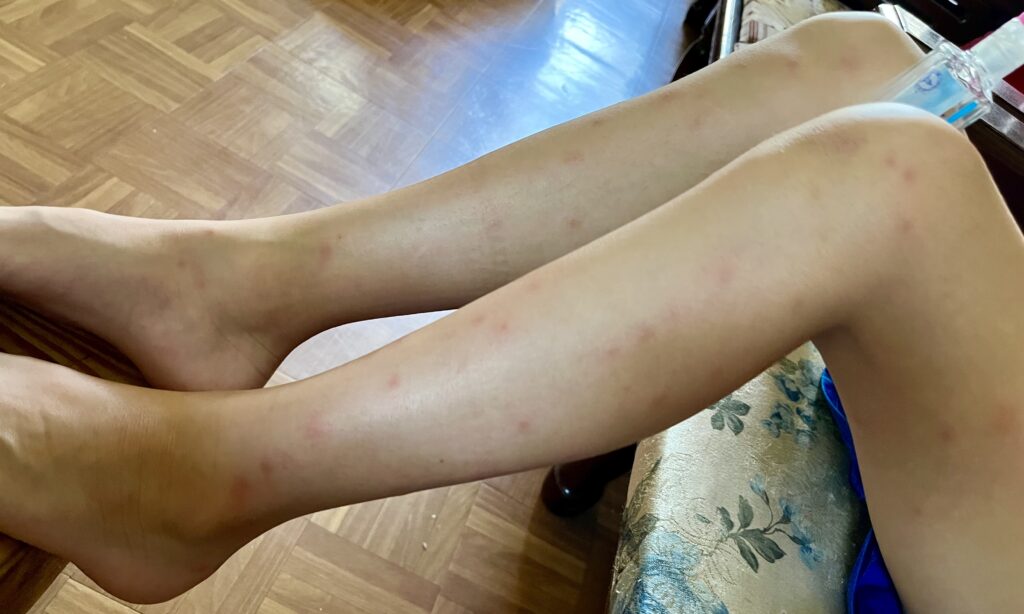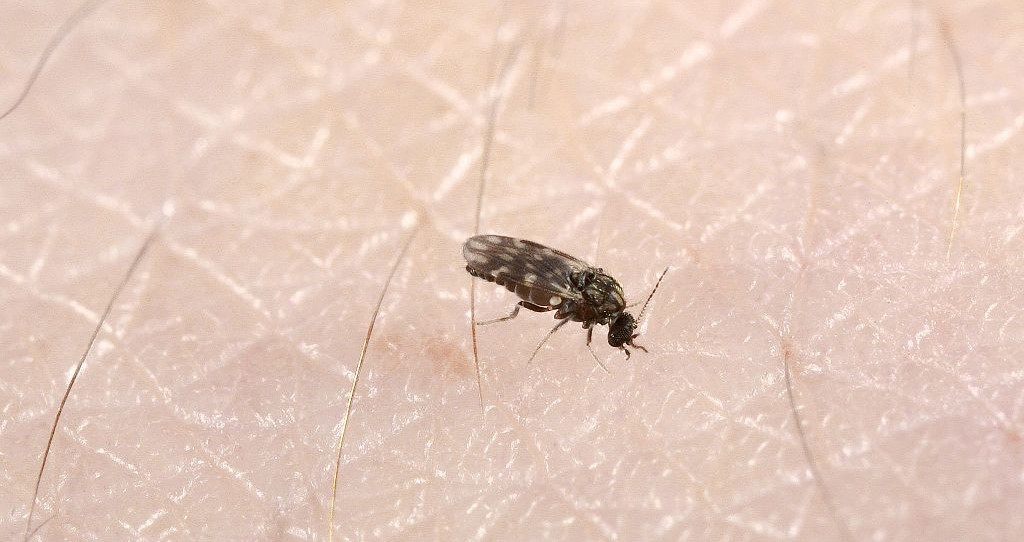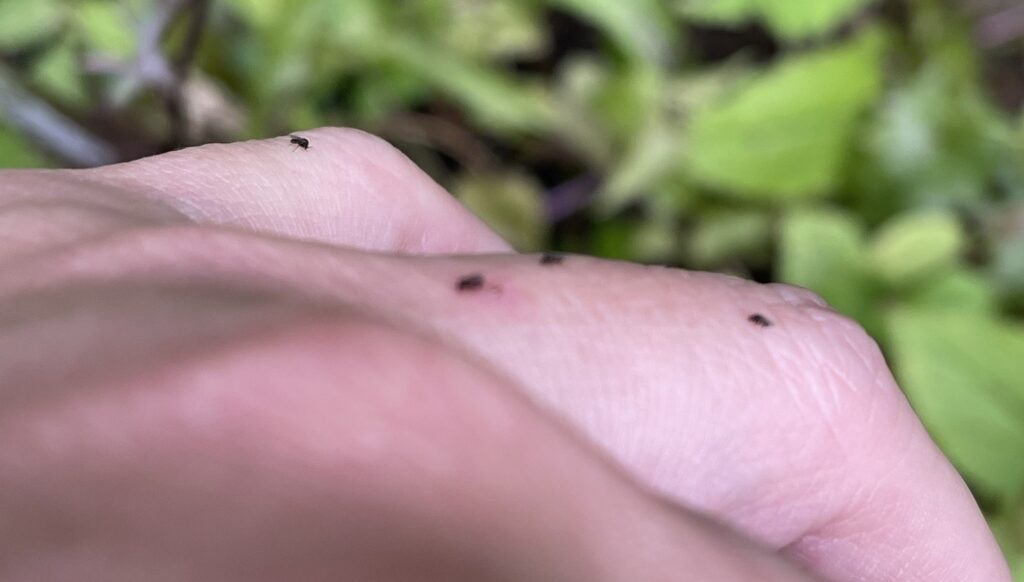A couple days after my family joined me in Taiwan, we went swimming in the rural mountains of Miaoli County, where my mom grew up. In the 15 minutes between emerging from the water and putting on insect repellent, my 10-year-old kid racked up over 100 intensely itchy insect bites. “We didn’t see any mosquitoes!” my partner protested, “How did we get bitten??”

When I told my uncle (who lives nearby) what happened, he said, “Maybe they are bites from 小黑蚊 (xiǎo hēi wén), little black flying bugs that suck your blood. They are so tiny you can’t even see them.”
Ah ha! These are the same type of insects we call “no-see-ums” in the US, also known as biting midges, in the family of small flies called Ceratopogonidae. Biting midges are found worldwide* except for Antarctica and the Arctic. These little buggers are just 1-4 mm in size. Some species of female midges cut skin and suck blood to get protein for egg-laying. They will bite and suck repeatedly until they are filled with blood. They can descend in large numbers onto exposed skin to feed. That’s probably how we got the 100+ bites within 15 minutes.

The severity of the bites varies depending how sensitized a person is to them. Some people have severe allergic reactions to the bites. A person who hasn’t had much exposure (like my kid) may get big red swollen and painful bites. Others with some past exposures (like me) may have a delayed reaction with bumps and itching appearing hours after the bite. People who are regularly exposed (like my uncle) can get desensitized over time and get little or no bumps or itchiness.
We found the midge bites to be itchier and last much longer (2+ weeks) than mosquito bites. The more we scratched these bites, the itchier they got. We had to treat our super-itchy bites with steroid cream and took antihistamine medications to reduce itching and scratching. Taiwan has an especially vicious biting midge species called Forcipomyia taiwana. These midge bites cause so much itchy and allergic grief in Taiwan that researchers are developing a vaccine to prevent midge-induced allergies.

Biting midges are known to carry microbes (viruses, bacteria and parasites) that infect many non-human animals but do not carry nearly as many human pathogens as mosquitoes. Mosquitoes remain the world’s deadliest non-human animal by carrying diseases (especially malaria) that kill around 1 million humans a year.
Unfortunately the midges and mosquitoes were not the only bugs to prey on us. After all, we are living in a microbial world. We are food for microbes in addition to blood-sucking insects. So far, we have fortunately avoided the microscopic bugs that insects carry. But we were not so lucky around microbial super-infection. My kid’s scratched up bites created an opening for bacteria and a little red area of itched skin rapidly grew into flaming hot patch of infection. He took a course of bitter-tasting antibiotics for the skin infection (cellulitis). A couple weeks later, he developed another skin infection from mosquito bites on his ears, for which we used a prescription-strength topical antibiotic cream. Thankfully he quickly recovered from both bouts of infections and joined us on more adventures. Covered up, of course.
After getting eaten alive in Miaoli, we were much more careful with our insect bite prevention strategies:
- When going outside:
- Covering up with clothing. Yes, even in the scorching and oppressive heat. I found that loose and light quick-drying clothing was the most comfortable (synthetics, silk or very light cotton).
- Putting insect repellent on exposed skin (and on top of sunblock). We primarily used picaridin and sometimes DEET, since they are the most effective against mosquitoes and biting midges, our greatest foes in Taiwan. We prefer using picaridin 20% lotion because it is less oily and smelly and doesn’t melt plastics. It felt safe and comfortable enough to apply on our neck, ears and cheeks. However, picaridin doesn’t last as long as higher percentages of DEET. I found that I would get a bite or two after several hours of hiking and sweating and would need to reapply. (REI has a useful guide to insect repellents.)
- Treating clothing with permethrin spray. I sprayed some of our hiking pants a week before traveling.
- Avoiding windless areas with standing water.
- Inside:
- Keeping doors closed and going in and out quickly to keep bugs out.
- Only opening windows with fine mesh screens on them.
- Using fans while sleeping to blow bugs away from our bodies.
- When I worked in Sub-Saharan Africa and parts of Asia where malaria is widespread, I also slept under mosquito nets.
Despite our bug bite prevention strategies, mosquitoes and midges still snuck inside and bit us while we slept… and bit us outside after getting out of the water before we could quickly cover up. By the end of the 4-week trip in Taiwan and Korea, we counted 174 insect bites on my child. Oof.
So: Do not underestimate tiny bugs! We certainly learned that lesson on this trip.
*Biting midges in the US: The US has three genera of biting midges that feed on the blood of mammals: Culicoides, Leptoconops, and Forcipomyia. In the 1940s and 50s, infestations of biting midges, mosquitoes and other insects in California were killed off using DDT, an insecticide banned in the US in 1972 due to links with thinning egg shells of peregrine falcons and California condors, and more recently with sea lion cancers and human risk for Alzheimer’s Disease and breast cancer. Nowadays other pesticides are in limited use against midges and naled is used for mosquito control over large areas. Pesticide sprays bring up lots of questions about environmental and ecosystem impacts, so we fall back on the individual prevention strategies listed above.
